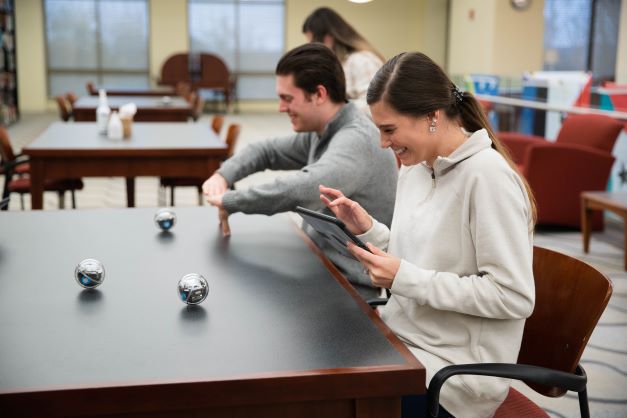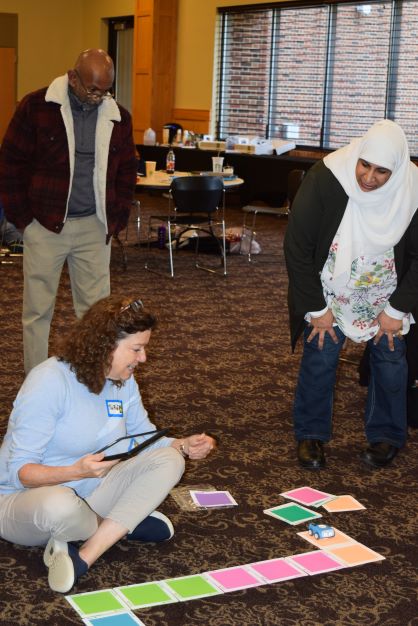By 2025, Indiana’s Department of Education will require all students in Indiana K-12 schools to have daily teaching in STEM topics. Through a unique collaboration, Indiana University Southeast has paired with schools, community, foundation, and business partners to prepare local teachers for teaching computer programming and robotics by integrating fun, interactive exercises with math or reading exercises.
STEM, which stands for Science, Technology, Engineering and Math, helps students improve their problem-solving and critical thinking skills, build collaboration and team building abilities, and prepare graduates for more technology-driven jobs that employers look to fill.
Through a School of Natural Sciences and School of Education partnership, IU Southeast is helping current and future elementary teachers learn new strategies for teaching and aligning curriculum to Indiana standards, as well as technologies and practices in computer science and robotics.

The project is made possible by a generous grant from the Caesars Foundation of Floyd County with additional support from Rivera Group and the IU Women’s Philanthropy Leadership Council to fund a year-long STEM initiative with three main goals: 1) to offer professional development and exposure to new technologies to in-service educators in elementary schools, 2) to utilize the latest equipment to enhance teaching skills and curriculum, computer science content knowledge, and instructional practices for future teachers enrolled in IU Southeast education programs, and 3) to offer opportunities to use the equipment and educational material with K-12 students in our region through Project AHEAD, an enrichment program for gifted and talented students offered by IU Southeast.
In the short term, the project serves elementary schools, elementary students, and elementary education majors at IU Southeast. In the long term, IU Southeast elementary education students who have learned how to integrate computer science and robotics into their teaching will be ready with the most advanced teaching skills when they enter local classrooms as in-service teachers. To date, four training sessions have been held, impacting 19 current elementary teachers and 20 current high school teachers from seven area school districts and 22 IU Southeast School of Education students.
Professors Suranga Hettiarachchi, associate professor of computer science and Sumreen Asim, associate professor of elementary science and education are the project directors for this initiative.

On Saturday, January 28, nine elementary school teachers assembled for the session to learn about combining Sphero robot programming with ongoing curriculum. Jorge Valenzuela facilitated the session, STEM Master Class, tools for teaching STEM and computational thinking in all subjects, with Asim and Hettiarachchi.
“Design is what engineers do,” said Valenzuela. “Computational thinking is the way to solve complex problems. Given the difficult times we currently have in education, students are not as engaged. These techniques of computational thinking help engage students.”
“The goal of this workshop is to give teachers practical take-and-use techniques they can use in their classrooms right away,” said Asim. “Robots in classrooms are relatively new. Using and programming robots help students with the five “E’s”—Engage, Explore, Explain, Elaborate and Evaluate.”
The teachers utilized two types of robots throughout the workshop, the Sphero Indi, a small robot resembling a car, is designed for the youngest learner; the Sphero Bolt, a spherical orb, is for more advanced learners. The participants used preprogrammed cards with the Indi to make the robots follow specific routes and instructions. The more advanced Bolt required using iPads to program the orbs to do desired tasks.
Additionally, the teachers discussed how to encourage and coach students through the initial frustrations of learning a new paradigm and how to embrace change. “Frustration that things don’t always happen the same way each time is part of computation thinking,” said Valenzuela. “Kids must learn perseverance; how to manage frustration. In those times they need to pause and take a moment to process it. They also need to learn it’s okay to fail.”
“My wheels are turning, I’d like to start writing lesson plans right away to incorporate these concepts into our core instruction,” said Tabitha Resener, from Fairmont Elementary School in New Albany. “In the past we did Tynker coding and the kids flourished. One specific child, an at-risk student, excelled. The students learned teamwork, to collaborate; they were excited to learn. Then we had to repurpose the rooms and lost our computer labs. This is something we could do anywhere as it requires no dedicated space. I know it is possible.”
For Asim and Hettiarachchi, the program is just beginning. The pair is currently working on a larger grant to seek funds for an expanded project in 2024 that will include funding for expansion of technology improvement in Floyd County Schools.
“Investing in STEM education is investing in the future of our community,” said Faye Camahalan, dean of the school of education “Our mission is to respond to the needs of K-12 schools, and STEM is one relevant component of the curriculum that must be met. Thank you to Caesars Foundation and Drs. Asim and Hettiarachchi for their initiative to contribute to the professional development of in-service and pre-service teachers in Floyd County. Integrating experiential learning experiences in computer science and robotics in K-12 classrooms will help advance the education of our kids.”


